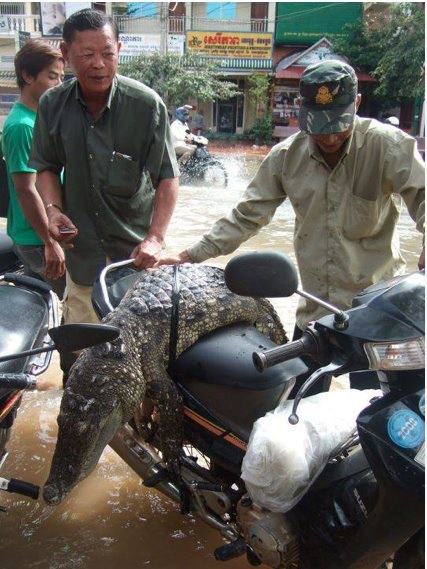

Top: Photo of Lolong, the world's largest crocodile in captivity.
Bottom: Escaped crocodile in Siem Reap. Photo from triple j Mornings.
Bottom: Escaped crocodile in Siem Reap. Photo from triple j Mornings.
Posted 12 December 2011
Original article at Global Voices
Written by Mong Palatino
A giant crocodile in southern Philippines and crocodiles in the flooded waters of Thailand and Cambodia were among the top news topics in Southeast Asia in the last quarter of the year.
Named Lolong, the giant crocodile was captured in Agusan del Sur province in southern Philippines and transferred to Bunawan Eco-Park and Research Center drawing more than 500 people a day. A visit by a team from National Geographic confirmed Lolong’s status as the world’s largest saltwater crocodile in captivity although it has to wait for half a year before Guinness World Records officially recognizes it. Lolong’s capture was Top 9 in the list of most shared stories on Facebook this year.
Filipinos also followed the story of Lolong and their online conversations made the giant crocodile a trending topic on the internet. Filipinos also compared Lolong to corrupt politicians whom they tagged as bigger ‘crocodiles’ in government.
Thailand’s worst flooding in the past half century killed more than 600 people and displaced thousands of residents and workers from their homes and factories. The flood disaster also inundated the country's estimated 3,000 crocodile farms. So aside from flood warnings, authorities and media networks also published crocodile alerts to remind the people to watch out for crocodiles which escaped from flooded parks and farms.
Here are some crocodile sightings and news reports: In Chonburi, crocodiles escaped from the Million Years Stone Park & Pattaya Crocodile Farm. After four days, the park chief said they recaptured 29 crocodiles but some were still missing. The park announced a reward of 5,000 baht for those who can provide information about the whereabouts of the escaped reptiles.
In the ancient city of Ayutthaya, around 100 crocodiles escaped from farms during the floods and authorities have issued a 1,000 baht bounty for each crocodile caught alive.
Crocodile farms near Bangkok were also flooded and fear quickly spread among residents who learned about the missing crocodiles. As floodwaters recede, crocodiles have been found in dry grounds looking for food. In Bang Bua Thong District, a crocodile was found in a Soi that was flooded with 50 centimeters of water.
Cambodia also suffered from a flooding disaster which was reported to be the worst in a decade. triple j Mornings reported on Facebook the presence of crocodiles in some of the flooded streets.
Oh hai pals! Back from Cambodia where beautiful land, wonderful locals and incredible food sustained me for a week. And floods. Siem Reap suffered it's most intense wet season in living memory, resulting in stuff like this… a coupla crocs from a nearby farm escaping and paddling through the city streets. Believe. See you tomorrow for less snappy adventures.
Written by Mong Palatino
A giant crocodile in southern Philippines and crocodiles in the flooded waters of Thailand and Cambodia were among the top news topics in Southeast Asia in the last quarter of the year.
Named Lolong, the giant crocodile was captured in Agusan del Sur province in southern Philippines and transferred to Bunawan Eco-Park and Research Center drawing more than 500 people a day. A visit by a team from National Geographic confirmed Lolong’s status as the world’s largest saltwater crocodile in captivity although it has to wait for half a year before Guinness World Records officially recognizes it. Lolong’s capture was Top 9 in the list of most shared stories on Facebook this year.
Filipinos also followed the story of Lolong and their online conversations made the giant crocodile a trending topic on the internet. Filipinos also compared Lolong to corrupt politicians whom they tagged as bigger ‘crocodiles’ in government.
Thailand’s worst flooding in the past half century killed more than 600 people and displaced thousands of residents and workers from their homes and factories. The flood disaster also inundated the country's estimated 3,000 crocodile farms. So aside from flood warnings, authorities and media networks also published crocodile alerts to remind the people to watch out for crocodiles which escaped from flooded parks and farms.
Here are some crocodile sightings and news reports: In Chonburi, crocodiles escaped from the Million Years Stone Park & Pattaya Crocodile Farm. After four days, the park chief said they recaptured 29 crocodiles but some were still missing. The park announced a reward of 5,000 baht for those who can provide information about the whereabouts of the escaped reptiles.
In the ancient city of Ayutthaya, around 100 crocodiles escaped from farms during the floods and authorities have issued a 1,000 baht bounty for each crocodile caught alive.
Crocodile farms near Bangkok were also flooded and fear quickly spread among residents who learned about the missing crocodiles. As floodwaters recede, crocodiles have been found in dry grounds looking for food. In Bang Bua Thong District, a crocodile was found in a Soi that was flooded with 50 centimeters of water.
Cambodia also suffered from a flooding disaster which was reported to be the worst in a decade. triple j Mornings reported on Facebook the presence of crocodiles in some of the flooded streets.
Oh hai pals! Back from Cambodia where beautiful land, wonderful locals and incredible food sustained me for a week. And floods. Siem Reap suffered it's most intense wet season in living memory, resulting in stuff like this… a coupla crocs from a nearby farm escaping and paddling through the city streets. Believe. See you tomorrow for less snappy adventures.
Written by Mong Palatino

No comments:
Post a Comment